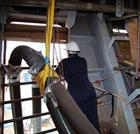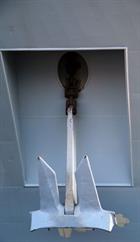Anchors aweigh on HMS Queen Elizabeth as carrier tests iconic weights
The mighty anchors on Britain’s biggest warship have been tested for the first time.
Nearly as the heavy as the jets which will operate from HMS Queen Elizabeth, the 13-tonne anchors were lowered on the carrier and into the huge basin in Rosyth where she is being completed.
The trial involving engineers from the Aircraft Carrier Alliance, who are building the 65,000-tonne leviathan, and the ship’s seamanship specialists who’ll be in charge of anchoring and mooring Queen Elizabeth, was the latest in a series of tests gradually preparing the future flagship for sea next year.
Engines have been fired up as have the generators, radars have been installed and flashed up, and soon the aircraft lifts – designed to take two F-35B Lightning II jets from the hangar to the flight deck – will be put through their paces.
For the seamanship team, however, observing the anchors at work was the highlight of Queen Elizabeth’s trials so far.
To raise and lower the two anchors, the ship relies on even heavier cables of shackles – huge metal links.
At 65,000 tonnes, everything about these ships is on a larger scale and the anchors are no different.
Chief Petty Officer Jay Early
The port cable is more than 1,300ft long – 400ft longer than the carrier herself – and weighs around 90 tonnes (more than six Merlin helicopters).
The starboard chain is slightly shorter and lighter (a mere 1,125 ft and 75 tonnes – or the weight of about five London buses).
“At 65,000 tonnes, everything about these ships is on a larger scale and the anchors are no different,” explained Chief Petty Officer Jay Early, Queen Elizabeth’s bosun, responsible for seamanship,
“Moving the anchor for the first time is a huge milestone in the programme and it was fantastic to watch it in motion as it was lowered into the water and back up again.
“For the newest joiners in my team, this was the first time they have actually seen the kit and there is no better way to learn than by doing.
“This is a great step forward as we continue to prepare the ship and make her ready for sailing next year.”




